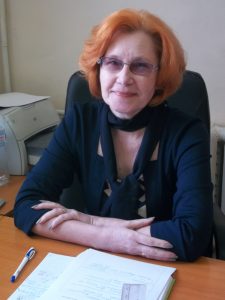
ONMedU library dates back to 1903, three years after the establishment of the medical faculty of Novorossiysk University. Director Natalia Garina spoke about the past, present and future of one of the oldest university libraries in Ukraine.

Is it true that the library was created by the students themselves?
In 1903, an initiative group of third-year students, our first enrollment, created a public library at their own expense. It numbered 2014 books and was named “Medical Student Library”. In 1920, the library of the Medical Institute was replenished with medical literature from the library fund of Mechnikov Novorossiysk University. Three years later, in connection with the creation of a stationary library, the student library was transferred to the administration of the Odessa Medical Institute, its first head was an orthopedist Boris Fedorovich Fonaryov, who died, unfortunately, during World War II. The history of the library is a very interesting and big issue, it cannot be retold in a few phrases. In 2003, on the occasion of the 100th anniversary of its creation, we published the book “The Temple of Communication with the World of Science”. The name reflects the attitude to the library and its great importance in the history of our university.
You have been heading the library since 2002. How has it changed during this time? What are you proud of?
Today it is a modern information center of the university. All major technological processes are automated: electronic book publishing, virtual customer service system, large databases. The local network connects 40 computers. Access to all the necessary information is in a couple of clicks.
We want readers to be comfortable first and foremost. At their service there are two specialized three-story buildings of scientific and educational literature, three reading rooms, four season tickets. All areas are equipped with WiFi.
The library funds have almost 900 thousand documents of scientific and educational literature in Ukrainian and foreign languages: monographs, dissertations, periodicals, reference books, textbooks, manuals. The electronic library contains more than five thousand documents. Our users have access to international bibliographic and scientific-metric databases – Hinari, Scopus, Web of Science, as well as annual subscriptions to scientific medical and biological periodicals, including English ones.
How did you manage to achieve such results?
First, it would be impossible without 55 dedicated employees and Deputy Director Natalia Antropova. We have a wonderful creative team.
Secondly, we were lucky with the rector. Everything I said would have remained a fantasy, if not for the support of Valerii Mykolaiovych Zaporozhan. Fortunately, he has always been a fan of innovations. Thanks to him, in 2008 a three-storey building of a modern student electronic library was built and equipped from scratch. I remember Valerii Mykolayovych saying during the opening: “It was a dream of my life.” And it’s not just words. We have the first professional book scanner AtisBookSnap in Ukraine. He gave a “second life” to a rare editions of the last century. Digital copies of these “pearls” are now open to a wide range of users through an electronic catalog. At the initiative of Valerii Mykolayovych, a publishing house was opened at the university, whose educational and scientific publications replenished our fund. A large number of textbooks, manuals, monographs – on digital media.
In general, have you managed to synthesize traditional and innovative forms of service?
We respect the traditions laid down by our predecessors: careful attitude to the library fund, succession of generations, obligatory focus on the full information content of the fund. At the same time, we innovate. Yes, the library still buys literature, introduces it to the reader in the reading room, and now offers to do so on the pages of virtual exhibitions and bibliographic indexes. Traditionally, we invite students to literary and thematic meetings, which are now necessarily accompanied by video presentations.
Not only the main tradition of the library of Odessa Medical University does not change – high professionalism of the staff and deep respect for His Majesty the reader-doctor, and it does not matter whether it is a beardless young freshman or gray-haired academician.
What projects are you currently working on?
The plan for the 2020-2021 academic year is to continue improving ONMedU Institutional Repository. This project is relatively new, created with the support of the Academic Council. We supported the global Open Access Initiative and created a repository. Its purpose is to increase the publishing activity of our scientists and students, to increase the scientific rating of the university in the world scientific community. As a result, the scientometric status of the educational institution is developing. Among the plans are comprehensive support for scientists in working with the main scientometric databases Scopus and Web of Science and the definition of an index for assessing their scientific performance.
Are you planning something for the 120th anniversary of the university?
A unique virtual exhibition dedicated to the rectors of our university, who headed it for 120 years, is being prepared for the birthday. The first issue of the retrospective bibliographic index “Obstetrics” became a significant contribution to the treasury of scientific work of the library, timed to the anniversary. It includes rare rarities from the foundations that founded our library.